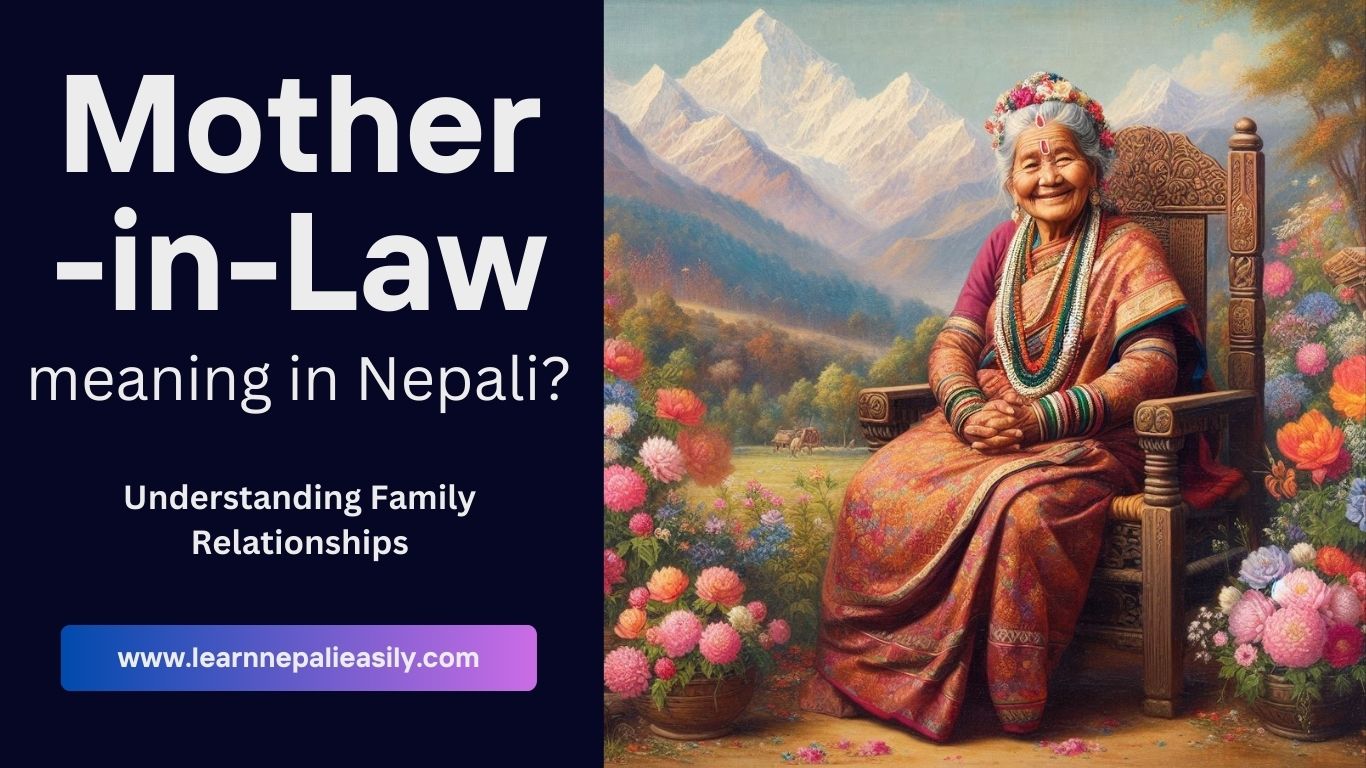In Nepali culture, the term “mother-in-law” holds great significance within family dynamics. As a key member of the extended family, the mother-in-law often plays a vital role in guiding and nurturing the household, especially in traditional settings. In this post, we’ll explore the meaning of “mother-in-law” in Nepali, how to use it in conversations, and some practical examples.
What is the Meaning of “Mother-in-Law” in Nepali?
The word “mother-in-law” is translated as “सासू” (Saasu) in Nepali. This term refers to the mother of one’s spouse, whether it is a son-in-law or daughter-in-law addressing their spouse’s mother. The term “सासू” (Saasu) is often spoken with respect, as the mother-in-law is considered an elder figure who commands respect in traditional Nepali families.
Using “Mother-in-Law” in Different Contexts in Nepali
The word “सासू” (Saasu) can be used in various contexts. Let’s look at how it’s applied in everyday conversations:
- Referring to the Mother-in-Law:
Sentence: “मेरो सासू मलाई धेरै माया गर्नुहुन्छ।” (Mero sasu malai dherai maya garnuhuncha.)
Translation: “My mother-in-law loves me very much.”
Here, “सासू” (Saasu) is used to refer to the mother-in-law in a respectful manner.
- Addressing the Mother-in-Law Directly:
Sentence: “आमा (सासूआमा), के तपाईंलाई केही चाहिन्छ?” (Aama (sasu-aama), ke tapailai kehi chahincha?)
Translation: “Mother-in-law, do you need anything?”
In this sentence, “सासूआमा” (Sasu-Aama) is a common way to address the mother-in-law directly, combining “सासू” (Saasu) with “आमा” (Aama), meaning mother. In daily conversation we use आमा (aama) instead of सासूआमा (Sasu-Aama).
- Describing the Role of a Mother-in-Law:
Sentence: “सासू घरको मुख्य भूमिका खेल्ने सदस्य हुन्।” (Sasu gharko mukhya bhumika khelne sadashya hunn.)
Translation: “The mother-in-law plays a key role in the household.”
In traditional families, the mother-in-law is often seen as a guiding figure for household matters, which is conveyed here.
Cultural Significance of “Mother-in-Law” in Nepali
In Nepali families, particularly in joint family systems, the relationship with the mother-in-law can be one of great importance. She is often considered the matriarch, responsible for passing down cultural values, family traditions, and offering wisdom. The bond between a daughter-in-law or son-in-law and the mother-in-law is traditionally nurtured with respect, care, and mutual understanding.
Common Nepali Phrases Involving “Mother-in-Law”
Here are some useful phrases that demonstrate the use of “सासू” (Saasu) in daily Nepali conversations:
सासूआमा खाना तयार छ। (Sasuaama khana tayar chha.)
Translation: “Mother-in-law, the food is ready.
मेरो सासूआमासँग राम्रो सम्बन्ध छ। (Mero sasuaamasanga ramro sambandha chha.)
Translation: “I have a good relationship with my mother-in-law.
तिमीले सासूलाई भेट्यौ? (Timile sasu lai bhetyau?)
Translation: Did you meet your mother-in-law?
सासूले आज खाना बनाउनुभयो। (Sasule aja khana banaunubhayo.)
Translation: My mother-in-law cooked the meal today.
मलाई सासूसँग कुराकानी गर्न गाह्रो लाग्छ। (Malai sasu-sanga kurakani garn gahro lagcha.)
Translation: I find it difficult to talk to my mother-in-law.
सासू सधैं बिहान चिया पिउनुहुन्छ। (Sasu sadhai bihan chiya piunuhuncha.)
Translation: My mother-in-law always drinks tea in the morning.
मेरो सासूको स्वास्थ्य ठिक छैन। (Mero sasuko swasthya thik chaina.)
Translation: My mother-in-law’s health is not good.
सासूले मलाई धेरै माया गर्नुहुन्छ। (Sasule malai dherai maya garnuhuncha.)
Translation: My mother-in-law loves me a lot.
तिमी सासूको घरमा कहिल्यै गएकी छौ? (Timi sasu ko ghar ma kahilyai gaeki chau?)
Translation: Have you ever been to your mother-in-law’s house?
मेरो सासूले नयाँ कपडा किन्नुभयो। (Mero sasule naya kapda kinnubhayo.)
Translation: My mother-in-law bought new clothes.
Conclusion
The term “सासू” (Saasu) meaning “mother-in-law” in Nepali is an integral part of family communication in Nepali culture. Whether you’re addressing your mother-in-law directly or referring to her in a conversation, using the term “सासू” appropriately shows respect and helps strengthen familial bonds. This post provides an overview of how to use the term, its cultural context, and practical examples, making it an essential guide for anyone navigating family life in Nepali households.

